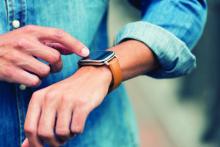The ability of an Apple Watch to detect atrial fibrillation (AFib) is significantly affected by underlying ECG abnormalities such as sinus node dysfunction, atrioventricular (AV) block, or intraventricular conduction delay (IVCD), a single-center study suggests.
“We were surprised to find that in one in every five patients, the smartwatch ECG failed to produce an automatic diagnosis,” study author Marc Strik, MD, PhD, a clinician at Bordeaux University Hospital in Pessac, France, told this news organization. “This [failure] was mostly due to insufficient quality of the tracing [60%], but in a third of cases, [34%], it was due to bradycardia, and in some cases, tachycardia [6%].
“We were also surprised to find that the existence of ventricular conduction disease was associated with a higher likelihood of missing AFib,” he said.
The study was published in the Canadian Journal of Cardiology.
Abnormalities affected detection
The investigators tested the accuracy of the Apple Watch (Apple, Cupertino, California) in detecting AFib in patients with various ECG anomalies. All participants underwent 12-lead ECG, followed by a 30-second ECG tracing with an Apple Watch Series 5. The smartwatch’s automated AFib detection algorithm gave a result of “no signs of AFib,” “AFib,” or “not checked for AFib (unclassified).”
Unclassified recordings resulted from “low heart rate” (below 50 beats/min), “high heart rate” (above 150 beats/min), “poor recording,” or “inconclusive recording.”
The smartwatch recordings were reviewed by a blinded electrophysiologist who interpreted each tracing and assigned a diagnosis of “AFib,” “absence of AFib,” or “diagnosis unclear.” To assess interobserver agreement, a second blinded electrophysiologist interpreted 100 randomly selected tracings.
Among the 734 patients (mean age, 66; 58% men) enrolled, 539 (73%) were in normal sinus rhythm (SR), 154 (21%) in AFib, 33 in atrial flutter or atrial tachycardia, 3 in ventricular tachycardia, and 5 in junctional tachycardia.
Furthermore, 65 (8.9%) had sinus node dysfunction, 21 (2.9%) had second- or third-degree AV block, 39 (5.3%) had a ventricular paced rhythm, 54 (7.4%) had premature ventricular contractions (PVCs), and 132 (18%) had IVCD (right or left bundle branch block or nonspecific IVCD).
Of the 539 patients in normal SR, 437 recordings were correctly diagnosed by the smartwatch, 7 were diagnosed incorrectly as AFib, and 95 were not classified.
Of the 187 patients in AFib, 129 were correctly diagnosed, 17 were incorrectly diagnosed as SR, and 41 were not classified.
When unclassified ECGs were considered false results, the smartwatch had a sensitivity of 69% and specificity of 81% for AFib detection. When unclassified ECGs were excluded from the analysis, sensitivity was 88%, and specificity was 98%.
Compared with patients without the abnormality, the relative risk of having false positive tracings was higher for patients with premature atrial contractions (PACs) or PVCs (risk ratio, 2.9), sinus node dysfunction (RR, 3.71), and AV block (RR, 7.8).
Fifty-eight patients with AFib were classified as SR or inconclusive by the smartwatch. Among them, 21 (36%) had an IVCD, 7 (12%) had a ventricular paced rhythm, and 5 (9%) had PACs or PVCs.
The risk of having false negative tracings (missed AF) was higher for patients with IVCD (RR, 2.6) and pacing (RR, 2.47), compared with those without the abnormality.


